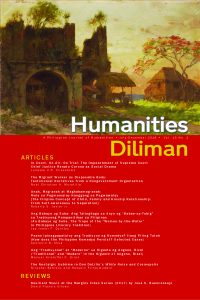 (JAN. 23) — Seven articles and a film review featured in the “Humanities Diliman: July to December 2018 issue” (HD Vol. 15 No. 2) are now available online.
(JAN. 23) — Seven articles and a film review featured in the “Humanities Diliman: July to December 2018 issue” (HD Vol. 15 No. 2) are now available online.
The articles are “In Court, On Air, On Trial: The Impeachment of Supreme Court Chief Justice Renato Corona as Social Drama” by Junesse d.R. Crisostomo; “The Migrant Worker as Disposable Body: Testimonial Narratives from a Nongovernment Organization” by Noel Christian A. Moratilla; “Anak, Mag-anak at Magkakamag-anak: Mula sa Pagmamalay Hanggang sa Pagwawalay” [The Filipino Concept of Child, Family and Kinship Relationship: From Self-awareness to Separation] by Roberto E. Javier Jr.; “An Babaye ug Suba: Ang Talinghaga sa Anyo ng “Babae-sa-Tubig” sa Tradisyong Pampanitikan sa Pilipinas”
(An Babaye ug Suba: The Trope of the “Woman-by-the-Water” in Philippine Literary Tradition) by Jay Jomar F. Quintos; “Paano Ipinagpapatuloy ang Tradisyon ng Komedya? Ilang Piling Tutok” (How does the Philippine Komedya Persist? Selected Cases) by Apolonio B. Chua; “Ang ‘Tradisyonal’ at ‘Moderno’ sa Higante ng Angono, Rizal” (“Traditional” and “Modern” in the Higante of Angono, Rizal) by Manuel Kristoffer C. Giron; and “The Nostalgic Sublime in Don DeLillo’s White Noise and Cosmopolis” by Niloufar Behrooz and Hossein Pirnajmuddin.
Crisostomo’s paper looks at the impeachment of Renato C. Corona, former Chief Justice of the Supreme Court of the Philippines, through the lens of Victor Turner’s Social Drama Theory. According to Prof. Patrick F. Campos, PhD, HD’s editor-in-chief, Crisostomo’s article “is an appraisal of the impeachment of Supreme Courts Chief Justice Corona as a social drama performed in the space where governmental politics, the law and mass media intersect.”
Moratilla’s article analyzes letters written by overseas Filipino workers (OFWs) through a two-pronged concept of resistance—one that fuses the discourse of critique with that of affirmation. Campos said the essay’s use of testimonies “seek to orient the narrative way from a romantic view of OFW life and toward a realistic one.”
Javier analyzes the words anak/c (the child), mag-anak (the family) and magkakamaganak/an (kinship relationship) using techniques in psycholinguistics. The editor notes that Javier’s article explicates the shifting Filipino notion of anak in a cultural economy that gives high premium to the value of utang na loob; traces the concepts of child, family and kinship and their movement in meaning from self-awareness to separation, and demonstrates the continued centrality of anak in modern Filipino psychology.
Quintos’s essay focuses on the image of the “woman-by-the-water” which has always been a recurring motif in Philippine epics and folk narratives. The author said folk tales about this discursive image were wrought by the different colors and shapes of colonization.
Meanwhile, Campos said it is worth noting that essays of Javier, Moratilla and Quintos “may be productively read together and appreciated for how they evaluate the crucial place of the woman in culture, literature, and society.”
Chua’s paper, on the other hand, “is structured differently,” says Campos. It focuses on komedya’s staying power in the Philippine theater. The author cited three cases that show komedya arts as being subjected to changes by various theater group agents.
Giron studies the higante-making practice of Angono, Rizal where the art form is one of the town’s prominent traditions. Campos said the author notes the formal changes that have been introduced to the designs of the giant human figures paraded during the festival that have been visible correspondences to history and current events.
In the last essay, authors Behrooz and Pirnajmuddin focus on Don DeLillo, known as a great postmodernist writer. The authors note that “because of his nostalgia for transcendence and “lost assurances,” he has become associated with modernism as well” and such was articulated in two of DeLillo’s novels.
HD Vol. 15 No. 2 also featured a review of Jose S. Buenconsejo’s video series “Resilient Music at the Margins Video Series” (2017) by David Francis Urrows of the Hong Kong Baptist University. This film includes three documentary films, namely, “Nature’s Presences. Music in Manobo Dulangan,” “T’boli, Obo, and Tagakaolo Communities in Southern Mindanao, Philippines;” “Sound Tenderness: Music of the Non-violent Palawanun Society in Southern Philippines;” and “Seven Dances of Life: Pledges to Others (Janji) in Two Sama Communities in Tawi-Tawi Islands, Southern Philippines.”
Humanities Diliman is an awardee of the Journal Challenge Grant through the Journal Incentive Program of the Commission on Higher Education. It is also a Scopus-indexed journal and is available via www.doaj.org and www.ebsco.com and has been listed in the ASEAN Citation Index at http://www.asean-cites.org/index.php?r=contents%2Findex&id=9.
To inquire about the journal’s printed version, contact the Office of the Vice Chancellor for Research and Development (OVCRD) at (02) 981-8500 local 4048 or (02) 436-8720. —Haidee C. Pineda, image courtesy of OVCRD
